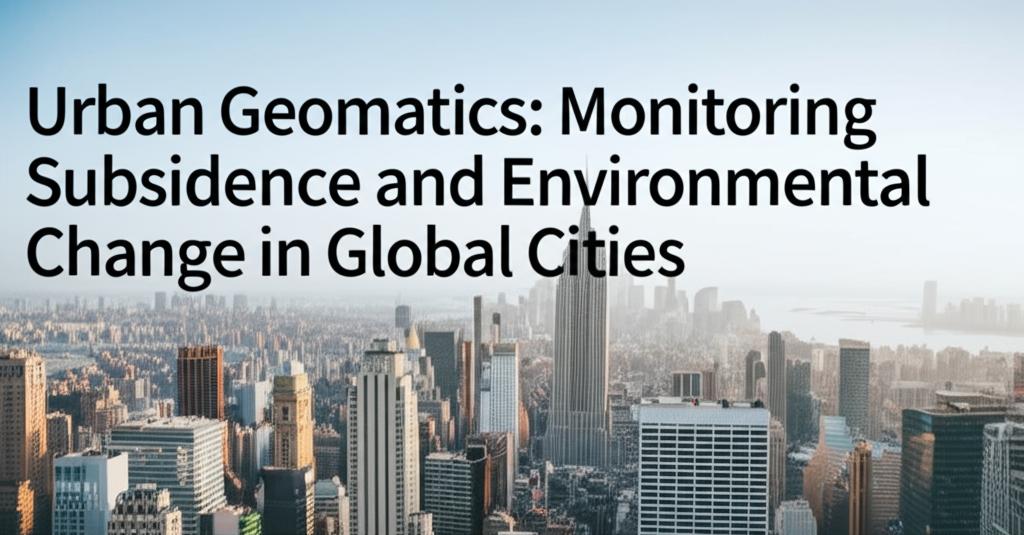Rapid urbanization and climate change are intensifying the challenges of land subsidence and environmental shifts in global cities. Urban geomatics, which integrates various geospatial technologies, plays a crucial role in monitoring these complex phenomena, providing vital data for sustainable urban planning and disaster mitigation.
Understanding the Problem: Subsidence and its ImpactsLand subsidence, the gradual or sudden sinking of the Earth's surface, is a significant geohazard in many urban areas worldwide. This phenomenon can be triggered by a combination of natural processes, such as the consolidation of alluvial soils, and human activities. Key anthropogenic drivers include excessive groundwater extraction to meet the demands of growing urban populations and industries, the construction of heavy infrastructure, and mining activities. In coastal cities, subsidence is often compounded by sea-level rise, leading to increased risks of flooding and saltwater intrusion into freshwater aquifers.
The environmental and socio-economic consequences of land subsidence are far-reaching. These include damage to buildings and infrastructure (e.g., roads, bridges, and utility lines), increased flood vulnerability, alterations in drainage patterns and river flow systems, and negative impacts on the quality of the living environment, including health and sanitation. In some cases, subsidence has been linked to catastrophic events like building collapses.
The Role of Urban Geomatics in MonitoringGeomatics offers a suite of powerful tools and techniques for monitoring land subsidence and associated environmental changes with high precision and over large areas. Key technologies include:
- Interferometric Synthetic Aperture Radar (InSAR): Techniques like Persistent Scatterer InSAR (PS-InSAR) are extensively used to detect and measure ground deformation with millimetre-level accuracy over time. By analyzing series of satellite radar images, PS-InSAR can identify stable points and track their displacement, revealing patterns and rates of subsidence across urban landscapes.
- Global Navigation Satellite Systems (GNSS): GNSS, including GPS, provides precise three-dimensional positioning, enabling the monitoring of vertical land movement at specific benchmark locations. This data is often used to validate InSAR results.
- Geographic Information Systems (GIS): GIS platforms are essential for integrating, analyzing, and visualizing diverse geospatial datasets, including subsidence measurements, land use/land cover (LULC) data, geological information, population density, and infrastructure maps. This allows for a comprehensive understanding of the relationships between subsidence, urban development, and environmental factors.
- Remote Sensing (Earth Observation): Satellite imagery from various sensors (e.g., Landsat, Sentinel) provides valuable information on LULC changes, urban sprawl, vegetation health, and water body dynamics. Analyzing time-series remote sensing data helps to identify environmental changes that may be linked to or exacerbate subsidence.
- LiDAR (Light Detection and Ranging): Airborne and terrestrial LiDAR systems can create highly accurate 3D models of urban environments, including buildings, infrastructure, and terrain. This data is useful for detailed assessments of structural integrity and changes in surface elevation.
The field of urban geomatics is continuously evolving, with increasing integration of cutting-edge technologies:
- Artificial Intelligence (AI) and Machine Learning (ML): AI and ML algorithms are being applied to automate complex tasks like feature extraction from satellite imagery, object detection, predictive analysis of subsidence and environmental changes, and identifying correlations between various datasets. GeoAI, the combination of AI and geospatial science, is enhancing our ability to model urban growth, manage traffic, and monitor environmental conditions in real-time.
- Internet of Things (IoT): Networks of IoT devices and sensors deployed across cities can provide real-time data on various environmental parameters, groundwater levels, and structural strain, contributing to more dynamic and responsive monitoring systems.
- Digital Twins: The concept of creating virtual replicas of physical urban spaces, enriched with real-time data, is gaining traction. Digital twins allow urban planners and managers to simulate different scenarios, such as the impact of new infrastructure projects or climate change effects, and to optimize resource allocation and disaster response strategies.
Recent studies highlight the effectiveness of urban geomatics in various global cities:
- Coastal Cities in Java, Indonesia: Research in cities like Pekalongan, Semarang, and Jakarta shows significant land subsidence rates, sometimes exceeding 10 cm per year, primarily due to groundwater extraction and geological conditions. Studies integrating PS-InSAR and Google Earth Engine have dynamically visualized subsidence and land cover changes, providing insights for spatial planning.
- Taipei City: Investigations using Sentinel-1 remote sensing data have revealed significant surface subsidence in areas with former river and lake beds, reaching up to 60 mm between 2017 and 2020. The study highlighted the correlation between subsidence, precipitation, and groundwater level changes, emphasizing the utility of remote sensing for urban planning and hazard identification.
- Arid Environments (e.g., Riyadh, Saudi Arabia): Rapid urbanization in arid regions can lead to unique subsidence triggers. In Riyadh, studies have identified wastewater discharge from septic systems, subsurface dissolution of karst formations, and the compaction of landfill materials as key causes of land subsidence, with rates up to -21 mm/year in some areas.
Despite significant advancements, challenges remain in urban geomatics for subsidence and environmental monitoring. These include ensuring data consistency across different sensors and platforms, managing and processing vast amounts of geospatial data ("big data"), and translating complex scientific findings into actionable policies for urban managers.
The future of urban geomatics lies in further leveraging AI and real-time data integration to develop more predictive and adaptive management strategies. Continued research and international collaboration, such as initiatives by UNESCO, are crucial for sharing knowledge, developing best practices, and building capacity to address the pressing challenges of land subsidence and environmental change in the world's rapidly growing urban centers. By embracing these innovations, cities can become more resilient, sustainable, and safer for their inhabitants.

